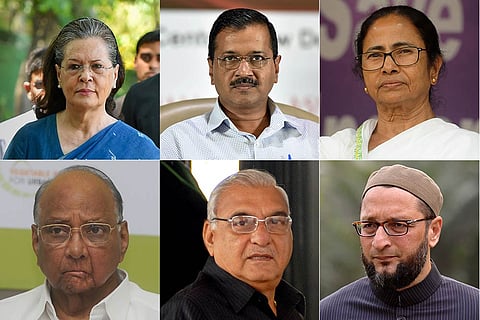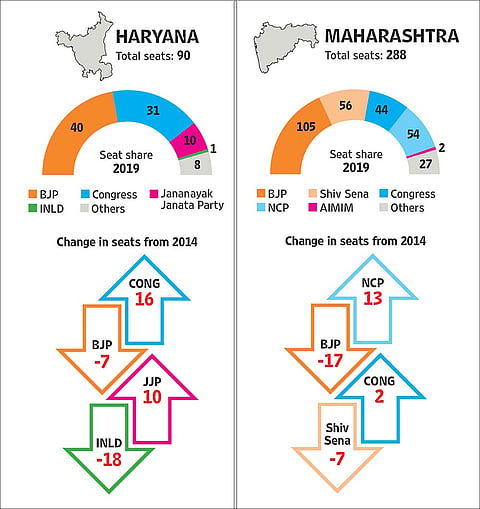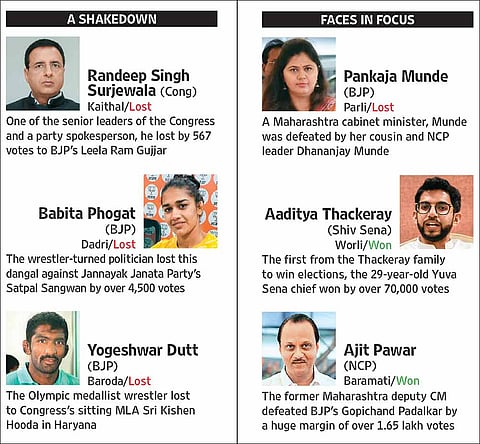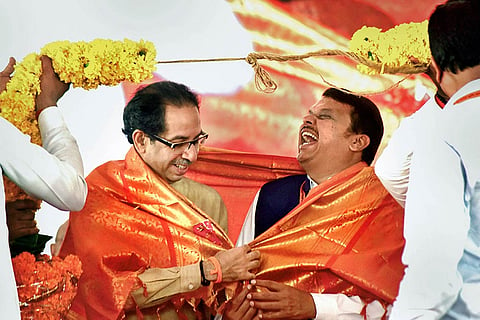Amid all the clamour of a mini election season and its aftermath—the expected and the surprising—we may forget that a decade is soon coming to a close in Indian life and politics. Quite a decade too, one that made all the noise of an epoch turning. For much of it, looming over centrestage was one man. Narendra Modi: the cause of ecstasy for some, of antagonism for others, and colossus-like for both. Also on stage, partly in the shadows, is a lady who had ceded centrestage to Modi. Sonia Gandhi had owned a good part of the previous decade, running a near-regency, succeeding against good odds. Now she’s back as Congress president, returning from semi-sanyas, a desperate holding operation to fill an apparent leadership vacuum left behind by a petulant Rahul Gandhi. After a partial referendum offered by the results of two assembly elections and a clutch of bypolls, how does it stack up for them?
It's A Local Call: Lessons From Maharashtra And Haryana State Elections
The assembly results hold long-term lessons for both the ‘nationalist’ BJP and a top-heavy, clueless Congress
Well, maybe that’s the wrong question to ask—or not the only one to ask. Not just because the day’s news has been full of unexpected twists in both Haryana and Maharashtra, but because a long-term view also calls for it. As the BJP and parties ranged on the Opposition side enter the future, there are signs of evolution across the board. How the people and the parties think about politics may inevitably change. How much of it should be about real-life issues, how much on ‘larger’ themes? Leadership is another central strand in the fabric. One hears these phrases often on the Opposition side…leadership vacuum, TINA factor. The irony of it strikes you when you look at the reality brewing out there on the political landscape—if a Sachin Pilot was actually passed over a year ago, now a fresh crop is blooming. Yes, they all bear known surnames…Thackeray, Reddy, what have you. Most surprising among them, a young Jat risen from the dust of Hisar: Dushyant Chautala. This phenomenon is something for the Congress to think deep about: too often it has distrusted or undermined genuine local talent to bolster the top. Now, of course, the leadership itself abdicated at a time when the voter seemed to be looking for alternatives.

To be fair, the broad pattern has held in the two states—and we are likely to see saffron regimes being sworn in again—but it’s a scorecard full of lessons for the BJP and Congress. For the BJP, this may be a good juncture for a strategic rethink. If one leaves aside the maha-verdict of the summer, it has faced too many embarrassing setbacks in local elections for introspection not to set in. Even Maharashtra and Haryana, while by no means a defeat, offer a sobering picture: a noticeable fall in seat-share compared to the 2014 assembly tally, and a rather precipitous one compared to summer. If assembly polls are about local issues, would it not imply a deficit in local governance? It is often touted that the CM does not matter for the BJP—nor even local issues like drought, farmer distress or community disaffection. Past trends have created an area of comfort for the BJP: the idea is that, despite everything, Modi’s talismanic aura would carry them through. But it was also a dual strategy that rested on blending Modi’s persona with a big, national narrative—Uttar Pradesh in 2017 was delivered thus, not on local issues but a pan-Indian theme like demonetisation.
Judged by that yardstick, there is room for some self-doubt. Maharashtra and Haryana have unique political ecologies, with issues specific to them. But, addressing over a dozen rallies there, Modi made it all about national issues—dilution of Article 370 in Jammu and Kashmir, criminalisation of instant triple talaq and implementation of National Register of Citizens (NRC) in Assam to strengthen the country’s security. The emerging duopoly in the BJP—with Modi’s hard-line on pan-national issues being only further sharpened by his trusted lieutenant, Union home minister Amit Shah—has not changed that. A micro-manager par excellence, Shah too campaigned extensively in the poll-bound states, at times addressing four to five rallies in a day. But the broad thrust was the same: a few canny moves on the social chessboard, and heavy nationalist shelling. And yet, even the OBC leader they had wooed over, Alpesh Thakore, lost a byelection in Gujarat (among two others).

Not everyone believes so. “The assembly results are a validation of Modi’s new politics. He set the narrative of nationalism during his first term, which is now being reinforced in a more confident, decisive manner. The Opposition parties have failed to counter his narrative, or come up with an alternate one. The old divisive discourse of Congress is no more acceptable to people,” says political analyst R. Balashankar, author of Narendra Modi – Creative Disruptor: The Maker of New India. He has a point. The Congress is not only in a leaderless limbo, it has also been cornered into a rhetorical dead-end—unable to find a viable place from which to criticise a ‘nationalist’ discourse. It was left to the voter to prove that ‘local’ does not equal ‘anti-national’—whatever life-saving gains that accrued to the Congress in these two states did not come via any strenuous effort made by its big leaders. The people simply seemed to seek them out. Perhaps there is a definable extent to which you can tell a drought-hit farmer with a crippling debt to feel proud because Article 370 has been taken away.

This same local-vs-national dichotomy is likely to play out in the coming electoral contests in different ways. That there aren’t too many of them in the near future may be a matter of relief for the Modi regime. Looming ahead is Delhi and Jharkhand. The first especially, despite its small size, is disproportionately significant. Intensive groundwork is already on to try and wrest back the initiative from Arvind Kejriwal’s Aam Aadmi Party (AAP) next year. Kejriwal has cannily evaded the old characterisation of him as an ‘anarchist’ with left-wing friends—he has neutralised those charges by simply not striking a dissent note on ‘nationalist’ issues, and instead making it a purely Delhi-centred discourse. He has thus seemingly stanched what seemed to be an all-round evisceration of AAP, and is hanging in there—certainly no walkover. The year after, local and national will clash in an even more visceral way, with the BJP having a go at Mamata Banerjee—trying to counter or subvert Bengali pride with the NRC and Hindutva. But there, and in succeeding assembly polls, one may find the BJP calibrating its strategy based on what it saw in this week’s results. There’re also regional players like Asaduddin Qwaisi’s AIMIM, who opened their account in Bihar by winning the Kisanganj bypoll, besides winning two seats in the Maharashtra polls.
Less Than Maha
On the bare detail, one could say the BJP and its allies returned to power with a comfortable majority. But that comes with enough caveats and nuances to make for an interesting, complex micro picture. In 2014, the BJP and the Sena had contested separately, winning 122 and 63 seats respectively. This time, despite fighting together, both their individual and combined tally has registered a good dip—judged against the Lok Sabha results, even more so. That it was a setback for the saffron alliance could not be denied: seven of its ministers, including Pankaja Munde, lost the polls. Therefore, it’s way short of the emphatic win the BJP was hoping for—it had even expected to gain a majority on its own, thus leaving only 124 seats for the Sena to contest. The sobering scorecard, by default, gave the Sena an upper hand, prompting it to stake claim to the top post, held by the BJP’s Devendra Fadnavis over the past five years.

Uddhav Thackeray with CM Fadnavis: Shiv Sena now has more bargaining power.
But it was the NCP which pulled off the biggest surprise. Led by battle-scarred veteran Sharad Pawar, the party improved its tally considerably and got more seats than its ally, the Congress. After being named in a corruption case by the ED, the 79-year-old Pawar sought to convert the challenge into an opportunity, leading the campaign from the front, holding rallies even in rains. The Congress, by contrast, was lacklustre and devoid of self-belief—making news more for prolonged internal squabbles or any attempt by the central leadership to gets its troops to cohere together.
That left a bristling and ambitious Sena to give a foretaste to the BJP of what the coming coalition government may look like. Sena chief Uddhav Thackeray was quick to assert that the time had come for the BJP to honour the 50:50 formula reached between them before the Lok Sabha polls. “We had reached this during Amit Shah’s visit to my house ahead of the general elections,” he announced at a presser in Mumbai. “Now the time has come to implement that.” Not explicitly stated, but it was clear he was hinting at chief ministership being shared for equal periods. Political pundits believe the Sena has chosen to drive a hard bargain, mostly to rub in the fact of the BJP’s diminution. Also, the victory of Uddhav’s son, Aaditya Thackeray, the first person ever from the Thackeray clan to have won an election, has come as a morale-booster.
Fadnavis, on his part, is digging his heels in, saying the pre-poll decision on leadership would stay, without elaborating on whether that meant a revolving chief ministership. “It’s after many years that a chief minister and a government has returned to power after completing a five-year tenure in the state,” is all he offers. Subtly deflecting the Sena, he claims at least 15 victorious rebels are already in touch with him. He also points out that the BJP’s numbers might have gone down from 2014 but its strike rate has improved. “We had fought 260 seats last time. This time, we fought 150 and won around 105. That’s a strike rate of 70 per cent,” Fadnavis says. Brave words, painted on a canvas less than enthusing, with ‘nationalism’ evidently unable to paper over farmer distress, rising unemployment and a sagging economy.
The Jat Resurgence
An even harsher rebuff was reserved for the BJP in Haryana—the very playfield of ‘nationalism’, at least in theory, with the state’s strong tradition of sending its sons to the forces. This is where Modi had inaugurated his pre-2014 run with a rally for army veterans, with the double advantage of the dominant Jat community having been conclusively saffronised over the years. But exactly five months after it swept the Lok Sabha elections in Haryana with a staggering 58 per cent voteshare, the state’s assembly poll results must have come as a rude shock for the BJP. Even if it may ultimately retain the state, this is on the back of a voteshare trimmed down to 36 per cent.
CM Manohar Lal Khattar had issued a bullish campaign forecast—‘abki baar 75 paar’ (this time 75+), and that in a House of just 90. As it turned out, this proved nothing more than bombastic rhetoric. A pro-incumbency vote may have worked for Modi in the Lok Sabha polls but relying on the continuance of a similar trend for a local election proved dear to the BJP. Again, it was that widening gap between a transcendental image, so to speak, and the earthier reality. Nearly all its cabinet ministers—Khattar himself and Anil Vij being notable exceptions—and its state president, Subhash Barala, crashed at the hustings. Celebrity candidates paradropped by the BJP in the poll ring—sports personalities Babita Phogat and Yogeshwar Dutt and TikTok sensation Sonali Phogat—too lost their debut electoral battles. This when, just months ago, utter lightweights like Sunny Deol and Hans Raj Hans had won on the back of a Modi wave.
More embarrassingly, the BJP failed to get a clear majority in the 90-member assembly. With 40 winning MLAs, the BJP is still poised to form the next government—most likely in alliance with young star Dushyant Chautala’s Jananayak Janata Party (JJP) and independents. The result, however, shows that Modi and Amit Shah’s gamble of anointing Khattar, a Punjabi Khatri, as chief minister of Jat-dominated Haryana five years ago had an obvious flipside.
Even if they collectively won fewer seats than the BJP, the real stars of the Haryana polls were Jat leaders—Congress satrap Bhupinder Singh Hooda and Dushyant, the grandson of former CM Om Prakash Chautala. Dushyant had split from his grandfather’s INLD a year ago to form the JJP after differences with his uncle Abhay Chautala. With 10 MLAs, Dushyant is now kingmaker—the BJP has offered him the deputy chief minister’s post. INLD’s traditional pocketboroughs of Uchana Kalan, Barwala, Julana, Narwana and Uklana have decisively shifted to the JJP. The 31-year-old Dushyant has now emerged as the flag-bearer of his great grandfather Devi Lal’s political legacy.

JJP’s Dushyant Chautala has emerged kingmaker.
Hooda, the other comeback star, had struck a hard bargain with Sonia Gandhi to stay on in the Congress party. He proved that he still is the state’s tallest Jat leader; though Dushyant could be a tough competitor for the community’s 27 per cent vote bloc in the coming years. Two months ago, Hooda was all prepared to form his own outfit because of differences with then Haryana Congress chief Ashok Tanwar. Sonia replaced Tanwar—he resigned from the party soon after—with her confidante Kumari Selja but tasked Hooda with leading the party’s campaign. Hooda also got a lion’s share of tickets for his loyalists. As results poured in, with the Congress more than doubling its 2014 tally of 15 seats to 31 seats, Hooda made it a point to declare that he could have ensured an absolute majority “if the party had acted in time” in handing him the reins. Even if that may be an exaggeration, it goes back to that same question of trusting and fostering local leaderships.
The 2020s
This evolving matrix is what India will take into the next decade. The BJP is working steadily towards making further inroads into the South and the East, but they would have to broaden their strategic menu, beyond relying exclusively on Modi’s charisma—lest they face the risk of running into diminishing returns. Of course, it still works. Political commentator Suhas Palshikar talks of how Modi still offers a “combination of populism and majoritarianism” to Indians long starved of a hero figure (see interview). A party general secretary claims the party is planning for the next 25 years. “Amit Shah is laying the groundwork to ensure the country remains saffron for decades ahead,” the BJP leader says. A young crop of leaders is being readied towards that end. Its so-called main rival, meanwhile, still appears clueless, despite the ground sometimes being conducive. “The exorcism of Congress continues,” says social scientist Shiv Visvanathan. “The Opposition has to invent an alternative myth, and myths are not so easy to invent. The Congress is not even a trailer. How is it going to be a movie?” And yet, more people bought tickets than was imagined possible. If a script comes by, along with a director who knows how to pick actors, India may well have a less monolithic decade to look forward to.
By Bhavna Vij Aurora with Giridhar Jha and Puneet Nicholas Yadav